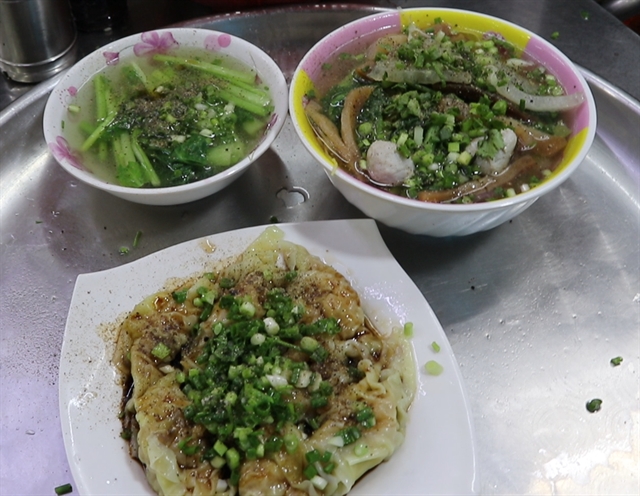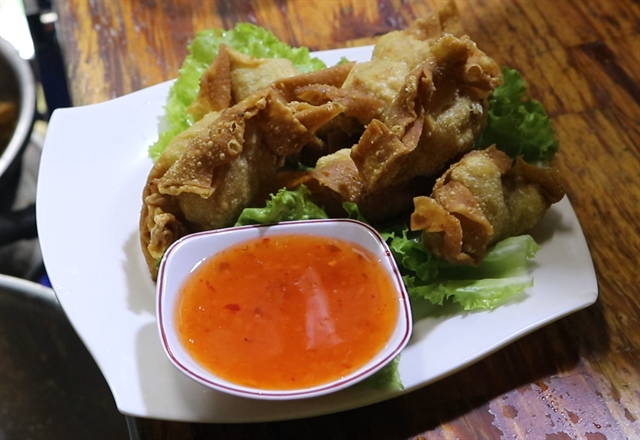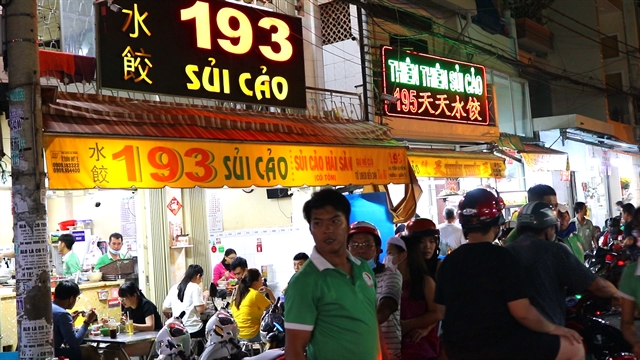 Life & Style
Life & Style

When HCM City locals think of jiaozi dumplings, or sủi cảo, they frequently think of Hà Tôn Quyền Street in District 11 where many restaurants run by Vietnamese of Chinese orign sell the dish every evening.
Việt Dũng

|
| Jiaozi dumpling, or sủi cảo, is a beloved dumpling dish that can be prepared and served in a wide variety of ways, such as with a bowl of broth or dressed with oyster sauce. — VNS Photo Việt Dũng |
When HCM City locals think of jiaozi dumplings, or sủi cảo, they frequently think of Hà Tôn Quyền Street in District 11 where many restaurants run by Vietnamese of Chinese origin sell the dish every evening.
Sủi cảo is one of the most popular Chinese dumpling dishes in Việt Nam, found in many restaurants around the country and loved by young and old alike.
Similar to other dumpling dishes, sủi cảo are squares of dough wrapped around a meat filling. While restaurants may prepare sủi cảo differently, the ones at Hà Tôn Quyền Street usually batter the pork and fish to a paste for the meat filling, and add seasoning and fresh shrimp.
Cooks typically prepare batches of raw sủi cảo by placing a spoonful of meat paste and one or two shrimp inside a square of wheat flour dough. Experienced staff can fold a piece of sủi cảo in a blink of an eye with only one hand.
Raw sủi cảo are normally cooked in two ways: deep fried or boiled in a huge pot of pork broth. After that, they can be served many ways: deep fried sủi cảo can be eaten with vegetables and plum sauce, while boiled sủi cảo can be served in a bowl of broth, drenched in oyster sauce and fried pork lard, or even with noodles.
Each way of preparing sủi cảo offers its own taste and dining experience. The crunchy, crusty layer of fried sủi cảo and its chewy meat fillings pair well with the sweet, sour plum sauce, while the light savoury tang of bone broth adds to the flavour of the softly boiled dumplings.
Restaurants on Hà Tôn Quyên Street often offer a generous heap of toppings for their sủi cảo broth, including fish balls, fish maw and pork rinds.
Vegetarian sủi cảo is also sold, ensuring that no matter your preference, you can still enjoy this beloved dish.

|
| In addition to boiling, raw sủi cảo can be deep-fried and eaten with plum sauce. — VNS Photo Việt Dũng |
Hà Tôn Quyền Street
Hà Tôn Quyền Street is often the first place that comes to mind when locals are asked about the dish. It is said that the cluster of sủi cảo restaurants has been around since 1995, and that the neighbourhood houses mostly Chinese descendants.
Nguyễn Thị Hồng Loan owns one of the 20 sủi cảo restaurants in the neighbourhood. Her restaurant is a family business that has been open for more than 20 years, but sủi cảo was not originally their focus.
"Back then, we mostly focused on noodle dishes and sold sủi cảo as a supplementary dish. But eventually customers ended up really liking our sủi cảo and ordered it more than noodles, so we shifted our focus."
"There are so many ingredients in it. I don't even know what some of them are," said Nguyễn Hoàng Anh Trí, a customer at Loan's restaurant who eats sủi cảo in the neighbourhood twice or three times a week.
Every evening, locals visit these restaurants for a quick and filling meal. During weekends, the road can be a chaotic gathering of families and friends ordering their sủi cảo, with outside staff beckoning and welcoming new customers, and chefs rushing to meet the demand of anticipating diners.
With so many sủi cảo sellers located so closely to one another, each restaurant in this competitive neighbourhood has found its own way of standing out from the crowd.
Dương Trường Lợi, who works at a sủi cảo restaurant that opened in 2000, said their broth is made with pork bone, chicken bone and shredded squid to give it a light, sweet and savoury flavour.
Nguyễn Trần Thảo Nguyên, a customer who has visited both of these restaurants, said the broth is tasty and has the light, savoury flavour of bone, without much other seasoning added, and that the extra toppings, especially pork rind, highlight the whole dish.
Prior to eating here, she said she was unaware that boiled sủi cảo could be served dry with oyster sauce, and that she now enjoys this unfamiliar way of serving sủi cảo.
While there are many restaurants that sell sủi cảo and other types of dumplings in HCM City, the sủi cảo road of Hà Tôn Quyền is certainly among the top places to sample the dish. — VNS

|
| Every weekend night, restaurants on District 11's Hà Tôn Quyền Street are packed with customers. — VNS Photo Việt Dũng |




